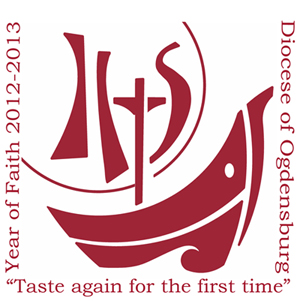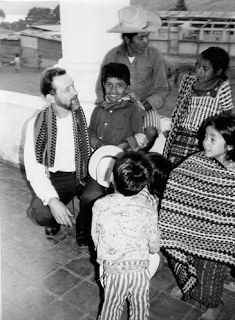April 3, 2013 By Father Jay Seymour Over this “Year of Faith” there has been a lot of emphasis, particularly in our own diocese, on pilgrimage. You can make virtual pilgrimages to Rome and elsewhere and also, throughout the year, there will be numerous opportunities to visit pilgrimage sites within and outside of the diocese. Though not on the diocesan list, I was privileged to make a wonderful pilgrimage/retreat this past January to Guatemala and El Salvador. It was orchestrated by the Maryknoll Fathers and Brothers who have now completed their fourteenth year of offering this unique Central American experience. Joining me were eighteen other priests and deacons from across the US and Ireland. The focus of this spiritual journey was to “walk in the footsteps of modern day martyrs,” referring to the many outstanding men and women representing our church who, on being caught up in the terrible civil war which raged in these countries during the 1980's and 90's, ended up giving their lives in witness to Christ and the Gospel. With several remarkable, Christ-filled Maryknoll missioners who had lived through these turbulent times as our guides, we visited the sites where a number of these modern day martyrs lived and gave their lives. The most famous of these recent martyrs would be Archbishop Oscar Romero. In meeting with those who knew him and walking the holy grounds where he lived, prayed and died, one comes away with a greater appreciation of his simplicity, his humility and his courage. He was one who took to heart and who truly lived the admonition of the Prophet Isaiah to “Make justice your aim: redress the wronged, hear the orphan’s plea, defend the widow” (Isaiah 1:17). He was a truly holy man who, for simply standing up for the rights of the oppressed and for seeking justice, reconciliation and peace, was targeted by the death squads. It was a moving experience to be able to visit the hospital chapel where he was shot while celebrating Mass and then celebrate Mass ourselves around the altar of sacrifice where his blood was shed. Just prior to his being killed (something which he anticipated) he prayed: “If God accepts the sacrifice of my life, then may my blood be the seed of liberty and a sign of hope that will soon become a reality ... a bishop may die, but the church of God - the people- will never die.” I can attest that some of the fruits of that prayer can be seen today in the church of El Salvador and beyond. We also visited the University of Central America in San Salvador where soldiers came in the middle of the night and murdered six Jesuits along with a domestic employee and her daughter. Back in Guatemala City it was just a short ride to the parish where Bishop Juan Gerardi was assassinated in 1998. Bishop Gerardi was head of a project documenting human rights violations during that war period. He interviewed many of the victims and/or witnesses of massacres, killings and other human rights violations during the war. Only two days after presenting the report at a special Mass attended by many family members of those same victims, he was killed. For Bishop Gerardi, like the others already mentioned and the many too numerous to mention, their only crime seemed to be fidelity to the teachings of Christ and to his Kingdom. One of the most memorable visits on this trip was to a small village in a remote area of Guatemala where we were introduced to one of the lesser known martyrs of this period, Father Stanley Rother. Father Rother was a simple farm boy from rural Oklahoma who seemed to be more comfortable on a tractor and as a handyman than laboring over Latin in seminary but he felt the call from God to the priesthood. Struggles with Latin did him in on his first try at a local seminary but he was given a second chance at Mount St. Mary Seminary in Maryland and was ordained in 1963. Shortly after the call came from Pope John XXIII for bishops to tithe their priests for countries of need, Father Stan volunteered and ended up in the mission of Oklahoma City in Santiago Atitlan, Guatemala. There, this same farm boy who struggled with Latin, mastered not only Spanish but also the native Tzutuhil dialect. Father Stan spent fourteen years as pastor, mostly peaceful years for him, but it was not long before the conditions of war brought fear and suffering to his flock. When soldiers came one night dragging away one of his catechists, the priest felt helpless in responding to his cries for help. Father Stan searched tirelessly in succeeding days to find his friend but to no avail. The catechist simply became another of the reported 50,000 “disappeared.” In the process of searching, Father Stan himself became a marked man and was put on a death list. For his own safety he returned to Oklahoma for a brief time but he did not want to leave his flock without a shepherd, abandoning them in their time of need. Knowing the dangers he faced, he returned to Guatemala. It was not long afterwards that, late one night, the soldiers came for him too. He was beaten and shot by the attackers leaving his body in a pool of blood, some of which came from where nails were used to mark his head with a crown of thorns. It was in 1981 that Father Rother was killed. The official Cause for his Beatification was begun in October 2007 but he is already revered by his native parishioners as “their saint”. His body was returned to Oklahoma for burial but his heart and blood (blood scooped from the floor where he was martyred) is enshrined in an altar of the parish church in Santiago Atitlan. As part of our pilgrimage we spent the night in this parish. It is a parish remarkable for its vibrancy marked by We may hear of problems in our church but there seems to be no doubt that here the church is alive and well, in no small part due to the blood of the martyrs that has been spilt on her behalf. Not all will be martyrs and not all will be able to make pilgrimages to Central America but, in faith, we are all pilgrims. As we continue our pilgrimage in this “Year of Faith” may we find the courage to witness to Christ and his Gospel in our own small ways, day by day, step by step, so that people may see more clearly that the church in Ogdensburg is alive and well too! Father Stanley Rother of Oklahoma is shown at left with children in Guatemala before he was killed in 1981. In January, Father Jay Seymour took part in a Year of Faith pilgrimage “walking in the footsteps of modern day martyrs,”organized by the Maryknoll Fathers and Brothers. Father Seymour reflects on the experience here. |
||||


 Masses with packed pews and with music provided by numerous youth choirs.
Masses with packed pews and with music provided by numerous youth choirs. 